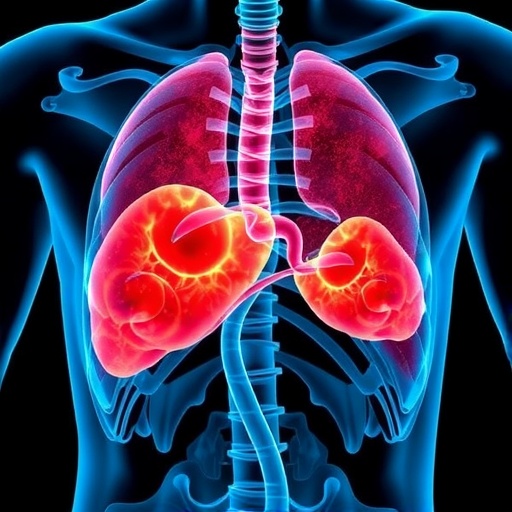In the rapidly evolving landscape of oncology research, a groundbreaking study published in BMC Cancer introduces a novel prognostic model for multiple myeloma (MM) that harnesses the intricacies of fatty acid metabolism. This research uncovers a molecular signature intricately linked with fatty acid metabolism-related genes (FMGs), offering new insights into disease prognosis and potential therapeutic targets in multiple myeloma, a complex hematological malignancy.
Multiple myeloma remains a challenging cancer to treat due to its heterogeneous nature and the evolving mechanisms of tumor progression and resistance. Recognizing the metabolic shifts that cancer cells undergo, the research team delved into the prognostic potential of fatty acid metabolism pathways—areas often underexplored in MM. Fatty acid metabolism is essential in cellular energy homeostasis, membrane biosynthesis, and signaling, all of which can influence tumor growth and the immune microenvironment.
To develop their model, the researchers integrated transcriptomic data from publicly available GEO and MMRF datasets, focusing on genes associated with fatty acid metabolism. Using weighted gene co-expression network analysis (WGCNA), they identified modules of co-expressed genes, followed by rigorous survival analysis via univariate Cox modeling. This systematic approach yielded 37 fatty acid metabolism-related genes significantly associated with patient survival outcomes in MM.
The next analytical leap involved applying least absolute shrinkage and selection operator (LASSO) regression to refine this vast gene pool to a robust signature of 16 key genes. This gene signature enabled the calculation of individualized risk scores for MM patients. Kaplan-Meier survival analysis demonstrated a stark contrast in prognosis between high-risk and low-risk groups, validating the model’s predictive power across both training and test cohorts. The area under the receiver operating characteristic (ROC) curve reached an impressive 0.787, underscoring its potential clinical utility.
Beyond prognostication, the researchers probed the tumor immune microenvironment, which plays a vital role in MM progression and response to therapy. Using CIBERSORT, an advanced computational method to quantify immune cell populations from transcriptomic data, they revealed that high-risk patients exhibited an immunosuppressive microenvironment. This insight implicates fatty acid metabolism not only in tumor cell-intrinsic behavior but also in sculpting the immune landscape that influences disease progression and therapeutic resistance.
Functional enrichment analyses, including Gene Ontology (GO), Kyoto Encyclopedia of Genes and Genomes (KEGG), and Gene Set Variation Analysis (GSVA), further delineated the biological underpinnings of the prognostic signature. Pathways involving cell cycle regulation, cellular aging, and metabolic processes emerged as significantly dysregulated in the high-risk cohort, suggesting that aberrations in these fundamental processes drive the aggressive nature of their disease.
To bridge the computational data with biological reality, the study validated expression patterns of pivotal genes—CCNA2, KIF11, and NUSAP1—at the mRNA level in bone marrow mononuclear cells from both newly diagnosed MM patients and healthy donors. The marked upregulation of these genes in MM samples corroborated their inclusion in the prognostic model and hinted at their functional importance in MM pathophysiology.
Further mechanistic insights were gained through in vitro functional assays. Knockdown experiments targeting CCNA2, KIF11, and NUSAP1 in MM cell lines induced significant cell cycle arrest and substantially reduced cellular proliferation. These findings illuminate key drivers behind the tumor’s proliferative capacity and underscore these genes as potential therapeutic targets to curb tumor growth.
The integration of metabolic gene signature with immune microenvironment analysis transcends traditional prognostic models, offering a multidimensional view of multiple myeloma progression. By linking fatty acid metabolism to immune suppression and tumor aggressiveness, this study may pave the way for novel therapeutic approaches that simultaneously target metabolic dysregulation and immune evasion.
Moreover, the clinical applicability of this predictive model is bolstered by the construction of a nomogram combining patient risk scores with other clinical parameters. Such tools could empower clinicians to stratify patients more effectively, guiding personalized treatment decisions and monitoring disease progression with enhanced precision.
This research exemplifies the power of interdisciplinary approaches — merging bioinformatics, molecular biology, and clinical data — to unravel complexities within cancer biology. The highlighted genes, particularly CCNA2, KIF11, and NUSAP1, offer promising avenues for developing targeted therapeutics that disrupt malignant cellular cycles and metabolic dependencies.
In summary, this extensive study unearths a fatty acid metabolism-related gene signature of remarkable prognostic value in multiple myeloma. It illuminates the multifaceted role of metabolic pathways in cancer progression and immune modulation, heralding a new era of precision oncology in hematological malignancies. Future investigations may expand upon these findings by examining the therapeutic efficacy of modulating these key genes and metabolic pathways in clinical trials.
With a comprehensive and integrative methodology, these findings represent a significant stride forward in understanding the metabolic underpinnings of MM and provide a hopeful outlook for the development of more effective, individualized therapies. As research continues to unravel the complex interplay between metabolism and immunity in cancer, this study sets a high standard for future explorations in precision oncology.
Subject of Research: Prognostic modeling based on fatty acid metabolism-related genes and immune microenvironment analysis in multiple myeloma.
Article Title: Prognostic value of fatty acid metabolism-related signature and integrated analysis of the immune microenvironment in multiple myeloma.
Article References:
Yu, Y., Che, F. Prognostic value of fatty acid metabolism-related signature and integrated analysis of the immune microenvironment in multiple myeloma. BMC Cancer 25, 1732 (2025). https://doi.org/10.1186/s12885-025-14886-3
Image Credits: Scienmag.com
DOI: 10.1186/s12885-025-14886-3 (Published 08 November 2025)
Tags: cancer treatment challenges in multiple myelomafatty acid metabolism and myeloma prognosisfatty acid metabolism-related genesgene co-expression network analysis in cancerimmune microenvironment in myelomametabolic shifts in cancer cellsmolecular signature of myelomaprognostic model for multiple myelomasurvival analysis in multiple myelomatherapeutic targets in myeloma treatmenttranscriptomic data analysis in oncologytumor progression in hematological malignancies





